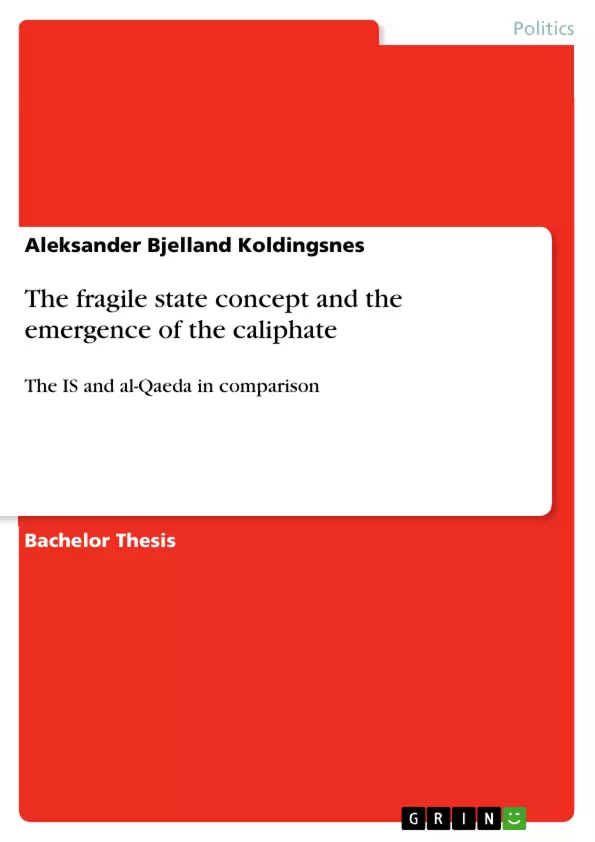The Islamic State´s [IS] establishment of a caliphate in 2014 received massive media coverage worldwide. The media has primarily focused on how IS use mass media, the Internet, extreme violence and lately, the terrorist attacks in Paris.
Terrorists who want to establish a caliphate are not new. Why exactly did IS establish a caliphate? Also, why didn´t al-Qaeda? This will be the main questions I want to explore in this essay. To answer these questions, I will utilize the fragile state concept.
Both al-Qaeda and IS have presented the establishment of a caliphate as one of their ultimate goals. Both organizations belong to the same Islamic school of theology: jihadist-Salafism. Both organizations have had success and become dominant groups in the jihadi cause. Therefore, it is interesting to compare the two groups in light of the status of Iraqi state to see if the fragile state concept can explain anything.
In this essay, I will compare 2000-2001 al-Qaeda with 2013-2014 IS. I have chosen two different periods in time because after 9/11 al-Qaeda was quickly reduced in terms of operational capabilities and changed its strategy from direct action to controlling and advising other affiliate groups. Thus, the assumed best chances for al-Qaeda’s ability to establish a caliphate was before 9/11. IS have fluctuated somewhat more regarding size and power but arguably increased in strength after US troops left Iraq in 2011 and the Syrian civil war erupted. As the caliphate was declared in 2014, this marks the time span that it is interesting to analyse IS.
This essay consists of five parts: a brief history of IS, al-Qaeda and Iraq, the concept and theory of fragile states and definitions, method, an analysis of the variables and a conclusion.
Inhaltsverzeichnis (Table of Contents)
- Introduction
- Historical background
- The Islamic State
- Al-Qaeda
- Iraq
- 2000-2001
- 2013-2014
- Concept and Theory of Fragile States
- Caliphate
- Method
- Discussion
- A fragile state?
- The loss of physical control of its territory or monopoly on the legitimate use of force
- The erosion of legitimate authority to make collective decisions and the inability to provide reasonable public services
- The inability to interact with other states as a full member of the international community
- Al-Qaeda
- Conclusion
Zielsetzung und Themenschwerpunkte (Objectives and Key Themes)
This essay aims to explore the connection between the fragile state concept and the emergence of the Islamic State's (IS) caliphate in 2014, specifically examining why IS, rather than al-Qaeda, was able to establish a caliphate. The essay uses the fragile state concept to analyze the situation in Iraq, comparing the circumstances surrounding al-Qaeda in 2000-2001 with those of IS in 2013-2014.
- The fragile state concept
- The establishment of the Islamic State (IS) caliphate in 2014
- The differences between IS and al-Qaeda
- The role of the Iraqi state in the emergence of IS
- The influence of the Syrian civil war on IS's rise
Zusammenfassung der Kapitel (Chapter Summaries)
The essay begins with an introduction, outlining the research question and providing context for the study. The next chapter examines the historical background of IS, al-Qaeda, and Iraq, focusing on the key events and figures that shaped the groups and the region. This chapter traces the evolution of IS from its founding in 2006 to its declaration of a caliphate in 2014, highlighting the role of influential leaders and the group's shifting strategies.
The third chapter explores the concept and theory of fragile states, defining the concept and outlining the characteristics of a fragile state. The chapter discusses the potential connection between a fragile state and the emergence of terrorist groups like IS and al-Qaeda, providing a framework for analyzing the situation in Iraq.
The chapter on the method outlines the specific approach taken in the essay, explaining the chosen time periods for comparison, the chosen variables for analysis, and the key sources of information. The discussion chapter focuses on the specific variables of the fragile state concept and their relevance to the emergence of IS. The chapter examines how IS's rise aligns with the characteristics of a fragile state, drawing comparisons with al-Qaeda's experience.
Schlüsselwörter (Keywords)
The primary keywords of this essay include the fragile state concept, Islamic State (IS), al-Qaeda, caliphate, Iraq, Syria, jihadist-Salafism, and terrorism. The essay focuses on the relationship between state fragility and the emergence of terrorist groups, specifically exploring how the characteristics of a fragile state contributed to the rise of IS and its declaration of a caliphate in 2014.
- Citation du texte
- Aleksander Bjelland Koldingsnes (Auteur), 2015, The fragile state concept and the emergence of the caliphate, Munich, GRIN Verlag, https://www.grin.com/document/337997



